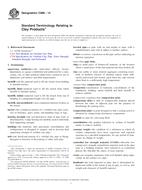Potrebujeme váš súhlas na využitie jednotlivých dát, aby sa vám okrem iného mohli ukazovať informácie týkajúce sa vašich záujmov. Súhlas udelíte kliknutím na tlačidlo „OK“.
ASTM C831-98(2013)
Standard Test Methods for Residual Carbon, Apparent Residual Carbon, and Apparent Carbon Yield in Coked Carbon-Containing Brick and Shapes
Automaticky preložený názov:
Štandardné skúšobné metódy pre zvyškového uhlíka, zdanlivý zvyškového uhlíka, a zdanlivú Carbon výnos v coked obsahujúce uhlík Brick a tvary
NORMA vydaná dňa 1.4.2013
Informácie o norme:
Označenie normy: ASTM C831-98(2013)
Poznámka: NEPLATNÁ
Dátum vydania normy: 1.4.2013
Kód tovaru: NS-15219
Počet strán: 7
Približná hmotnosť: 21 g (0.05 libier)
Krajina: Americká technická norma
Kategória: Technické normy ASTM
Kategórie - podobné normy:
Anotácia textu normy ASTM C831-98(2013) :
Keywords:
carbon yield, coking, loss of ignition, refractories, residual carbon, ICS Number Code 91.100.15 (Mineral materials and products)
Doplňujúce informácie
| Significance and Use | ||||||
|
3.1 These test methods are designed for use with carbon-containing products. The residual carbon content of a coked carbon containing brick or shape is an indication of how much carbon may be available, in service, to resist slag attack on, or oxidation loss of, that body. Apparent carbon yield gives an estimate of the relative efficiency of the total carbonaceous matter to be retained as residual carbon. 3.2 Residual carbon has a direct bearing on several properties of a pitch or resin containing refractory such as ignited porosity, density, strength, and thermal conductivity. 3.3 These test methods are suitable for product development, manufacturing control and specification acceptance. 3.4 These test methods are very sensitive to specimen size, coking rates, etc.; therefore, strict compliance with these test methods is critical. 3.5 Appreciable amounts of reducible components, such as Fe2O3, will have a noticeable effect on the results. Thus, values obtained by these test methods will be different when brick removed from service is tested. This must be kept in mind when attempting to use these test methods in an absolute sense. 3.6 Oxidizable components such as metals and carbides can have a noticeable effect on the results. This must be kept in mind when using the second procedure, which is based on measuring weight loss after igniting the coked specimens. 3.7 Testing of brick or shapes that contain magnesium metal presents special problems since this metal is highly volatile and substantial amounts of the magnesium can be lost from the sample during the coking procedure. This must be kept in mind when interpreting the results of testing of brick that contain magnesium. In addition, magnesium can react readily with atmospheric humidity. This must be kept in mind when storing brick that contain magnesium. |
||||||
| 1. Scope | ||||||
|
1.1 These test methods cover the determination of residual carbon content in carbon-bearing brick and shapes after a prescribed coking treatment. They provide two procedures. The first procedure is based on the combustion of carbon and its measurement as carbon dioxide. However, when using the first procedure for articles that contain silicon carbide or other carbides, no distinction will be made between carbon present in the form of a carbide and carbon present as elemental carbon. The second procedure provides a method for calculating apparent residual carbon (on the basis of weight loss after igniting the coked specimens), apparent carbonaceous material content, and apparent carbon yield. If the second procedure is used for brick or shapes that contain metallic additives or carbides, it must be recognized that there will be a weight gain associated with the oxidation of the metals, or carbides, or both. Such a weight gain can change the results substantially and this must be kept in mind when interpreting the data. 1.2 The values stated in inch-pound units are to be regarded as the standard. The values given in parentheses are for information only. 1.3 This standard does not purport to address all of the safety concerns, if any, associated with its use. It is the responsibility of the user of this standard to establish appropriate safety and health practices and determine the applicability of regulatory limitations prior to use. |
||||||
| 2. Referenced Documents | ||||||
|
Podobné normy:
Historická
1.6.2013
Historická
1.1.2009
Historická
1.4.2009
Historická
1.9.2014
Historická
1.4.2009
Historická
15.12.2013



 ASTM C778-13
ASTM C778-13 ASTM C837-09
ASTM C837-09 ASTM C880/C880M-09..
ASTM C880/C880M-09.. ASTM C896-14
ASTM C896-14 ASTM C97/C97M-09..
ASTM C97/C97M-09.. ASTM C980-13a
ASTM C980-13a
 Cookies
Cookies
